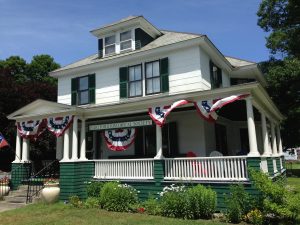Join Us!
Our nation’s history unfolded in Hartford, VT from before the American Revolution through exciting agricultural, industrial, and technological eras. Become a member today and help us explore America’s fascinating past. Individual memberships are just $25 per year. Please click on the membership button at the bottom of any page.
Hartford’s Five Villages
Hartford Village was originally called White River Village. It has a diverse commercial history, having produced at various times cotton, chairs, farm tools, flour, lumber, carriages, sleighs, and asbestos fertilizer. It was home of the Hartford Woolen Company — with its connections to the Lyman, Morris and Cone families. The village is the birthplace of Dr. Horace Wells, the first to discover the use of nitrous oxide — “laughing gas” — as an effective pain killer. The Village is listed by the Vermont Division of Historic Sites as a State Historic District.
Wilder was originally called Olcott Falls. The name was changed in 1897, fifteen years after Charles Wilder arrived to erect a dam and to construct a paper mill and a “planned community.” In consideration for changing the name, Wilder’s estate financed the construction of an iron bridge across the Connecticut River to New Hampshire. The bridge, the dam and the paper mill were demolished in 1950 when the present Wilder Dam was erected to generate electricity. Wilder’s status as a State Historic District is in process as of 1999.
White River Junction is located at the confluence of the White and Connecticut Rivers and was the first (1848) and the largest railroad center in the state and in New England north of Boston. It was described in 1884 as having “…a fine large union depot, four churches… a large hotel, several stores of various kinds…” That description still holds today even though the depot burned down three times and the hotel twice. All were rebuilt without damaging the architectural integrity of the downtown area, which reflects the urban architecture of the late 1800’s and early 1900s. White River Junction is also a State Historic District.
Quechee, another State Historic District, is the site of Quechee Gorge (one of Vermont’s more famous natural wonders) and of the Quechee Lakes planned community. For many years it was primarily a mill town noted for its woolen products, the most prominent being the Harris Emery Company and the A.G. Dewey Company. Of the historic sites in Quechee, the most famous is the Burtch/Udall “Theron Boyd” house. Built in 1786, the period when Vermont was an independent republic, it remains essentially unchanged since 1805. Recently saved from destruction, the house is owned by the Vermont Division for Historic Preservation.
West Hartford got its start as a mill village on the White River. With the coming, in 1848, of the first railroad spur in Vermont (which ran between White River Junction and Bethel), West Hartford became primarily a stage stop connecting the more rural neighboring townships with the Central Vermont Railroad. It is also distinguished by having the only library owned by the Township (the others being trusteeships). This came about when the 1927 flood destroyed the 1922 library, and a new library was donated by the City of Hartford, Connecticut. The Appalachian Trail passes through the village as well.
The Garipay House
 The Garipay House, located at 1461 Maple Street in Hartford Village, is the home of the Hartford VT Historical Society. The house contains the society’s archives and museum. This historic home was bequeathed to the Society in 1994 by the late Loretta Michota Garipay. Loretta and Stanley Garipay were physicians and the mid-twentieth century medical office of Dr. Stanley Garipay has been preserved. The Garipay House is open to the public by appointment. Please call 802/296-3132.
The Garipay House, located at 1461 Maple Street in Hartford Village, is the home of the Hartford VT Historical Society. The house contains the society’s archives and museum. This historic home was bequeathed to the Society in 1994 by the late Loretta Michota Garipay. Loretta and Stanley Garipay were physicians and the mid-twentieth century medical office of Dr. Stanley Garipay has been preserved. The Garipay House is open to the public by appointment. Please call 802/296-3132.
Events
MONTHLY BOARD MEETINGS are open to the public on the second Monday of the month at the Garipay House at 6 p.m. (Please check for exact date.)
The Hartford VT Historical Society offers educational programs in April, June, September, and November. Programs are open to the public and free of charge.
Newsletter
The HHS publishes newsletters in March, May, July, September, and November. Past issues can be downloaded here.
Collection
Browse our online catalog of historic artifacts by name, keyword, or category. This is a work in progress and you are welcome to help. Click here to visit the Catalog website.
Hartford Historical Society
1461 Maple St.
Hartford, VT 05047
(802) 296-3132
info@hartfordhistoricalsociety.com